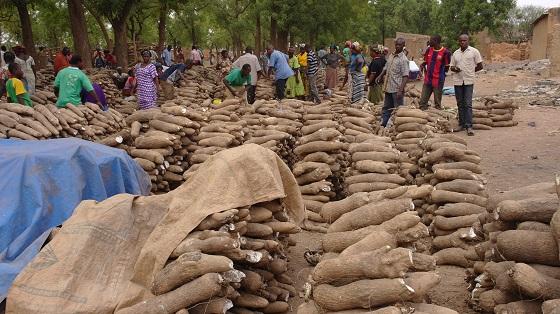Biophysical, institutional and economic drivers of sustainable soil use in yam systems for improved food security in West Africa (YAMSYS)
Yam (Dioscorea sp) is an underutilised crop despite it feeds 155 million persons in the tropics. The increase in yam production in West Africa over the last decades was mostly realised through increasing the area under cultivation, while tuber yield increased only slightly.
About the project
Background
Yams are tuber crops essential for food security in West Africa. They can also be a significant source of income for the actors involved in the yam chain value (producers, traders, processors) as their tubers are highly appreciated by urban populations. They are also a very important part of West African culture and are present in many rituals and ceremonies. Traditionally yams are grown without input as the first crop after long-term fallow or natural vegetation in slash and burn systems. However, tuber productivity of traditional cropping systems is much lower than the yield potential. One of the reasons explaining this low productivity and the fact that yams have to be planted on new land is the high level of soil fertility required by these plants and its rapid decrease when the plot is cropped with yams. Given the high prevalence of food insecurity, poverty and environmental degradation in West Africa, measures to improve the soil fertility in yam cropping systems should be developed and implemented as soon as possible.
Objectives
YAMSYS aims at developing sustainable methods for soil management that will allow settling yams in long-term crop rotations, increase tuber yields and increase income of the actors working along the yams chain values. To reach these goals we carry out research both on biophysical aspects to assess the effects of soil management options on soil fertility and yams yield and on the socio-economic and institutional settings to understand the drivers of soil use and the role of these crops. Innovation platforms gathering the important project stakeholders are installed at each of the 4 pilot sites (2 in Côte d’Ivoire and 2 in Burkina Faso). Based on continuous discussions and on results delivered by the research, these platforms elaborate and validate innovations that will have a sustainable impact in the region.
Relevance
Improved soil management will decrease the need for new land, increase and stabilize yam production, and improve food security and income at household level. Since there is a strong demand for yam by consumers, the results of the project will positively impact the actors of the entire yam value chain. Finally yams are just one group of neglected crops among others that play an important role in the livelihoods of poor people in the tropics. YAMSYS aim to serve as a model for analysing underutilised tuber and root crops in the tropics and for developing and implementing innovations that benefit both their producers and society at large.
Highlights and selected results
The preliminary results show a diversity in biophysical characteristics both between and within the study sites. Based on soil properties (clay, carbon, water infiltration) the site with the highest soil fertility is Tiéningboué followed by Liliyo, Midèbdo and Léo. The socio-economic conditions are also diverse between and within sites. A survey conducted in three villages around Tiéningboué in March 2017 reported a large ethnic diversity in the region and a large diversity of cropping systems between and within communities. The results of the experiments on soil options co-constructed within the Innovation Platforms conducted in the mother trials installed at the four sites during the first year show that the two yam species (D. alata and D rotundata) responded to mineral and organic fertilizations. In Liliyo the project reached almost 40 t fresh tuber ha-1 in fertilized plots which was the targeted yield. In Tiéningboué, the use of healthy seed and the highest planting density in the mother trials (1 plant m-2) led to improved fresh tuber yield compared to the yields measured in farmers’ fields. In Léo and Midébdo, because of a late planting of the mother trials leading to water stress there was no significant yield increase with the tested soil options compared to farmers’ field. Stakeholders were very interested in the mother trials. At each site, more than 100 farmers showed an interest to test the soil options in their own fields in baby trials. The innovative yam staking and storage (photos 1 and 2) promoted by the project in demonstration fields gathered strong interest from the producers who also wanted to experiment those innovations on their farms.
Geographic scope
- Côte d’Ivoire
- Burkina Faso
Project website and links to P3
- Link to project website
- Links to project phase 1 (2015-2017) and to project phase 2 (2018-2021) on SNSF research database P3

